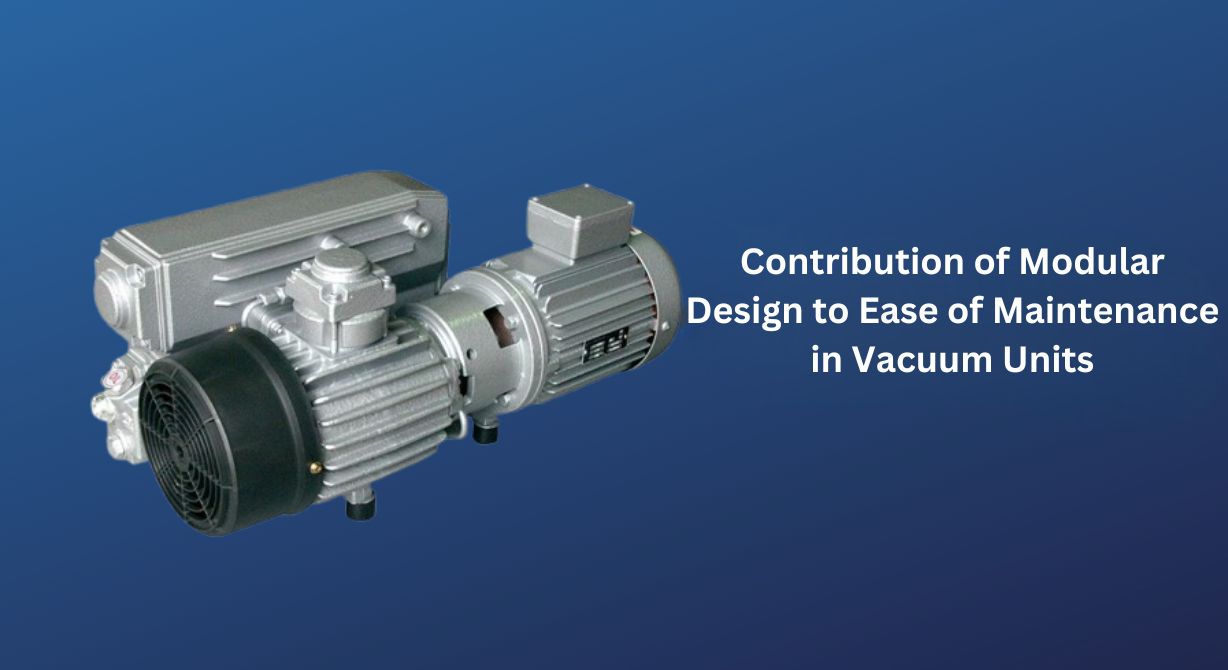Contribution of Modular Design to Ease of Maintenance in Vacuum Units
Table of Contents
- How Does Modular Design Simplify Maintenance for Industrial Vacuum Systems?
- A Maintenance Engineer's Guide to Reducing Downtime with Modular Vacuum Units
- Ways Modular Vacuum Unit Design Lowers Your Total Cost of Ownership
- Modular vs. Monolithic Vacuum Systems: A Comparative Analysis for Maintenance Efficiency
- What Are the Key Modular Components That Streamline Vacuum Unit Repair?
- Maximizing Uptime: The Strategic Role of Modularity in Vacuum System Maintenance
How Does Modular Design Simplify Maintenance for Industrial Vacuum Systems?
The operational integrity of industrial vacuum systems is paramount, and modular design represents a fundamental shift in achieving this goal. By constructing a vacuum system from discrete, self-contained units, engineers can address specific failures without disrupting the entire production line. This approach transforms maintenance from a complex, time-consuming overhaul into a targeted, predictable procedure, directly enhancing overall system uptime.
At the core of this methodology is the principle of component interchangeability. Critical elements such as filters, motors, and separators are designed as standardized modules. When a specific component fails, maintenance personnel can simply isolate and replace that module, drastically reducing mean time to repair (MTTR). This eliminates the need for specialized technicians to perform intricate in-situ repairs, minimizing labor costs and production delays. The systems from Gücüm Pompa exemplify this, where a faulty power unit or a clogged filter can be swapped in minutes rather than hours.
This design philosophy also simplifies preventive maintenance protocols. Instead of scheduling extensive downtime for system-wide inspections, modules can be rotated out for servicing or replacement based on their individual operational lifecycle. This proactive strategy prevents catastrophic failures and ensures consistent vacuum performance in demanding applications like cement handling or pharmaceutical powder conveyance.
Furthermore, modularity offers significant commercial advantages in terms of inventory management and future-proofing. Facilities can stock critical spare modules instead of a vast array of individual parts, optimizing warehouse space and capital expenditure. As production needs evolve, the system's capacity or functionality can be upgraded by integrating new, compatible modules from Gücüm Pompa, extending the asset's service life without a complete capital investment.
In environmental applications, such as capturing hazardous dust or managing industrial waste, the benefits of modularity are equally critical. The ability to quickly replace a filtration module that has reached its capacity ensures continuous compliance with environmental regulations and protects worker safety. This robust, service-oriented design ultimately translates into a lower total cost of ownership, making modular industrial vacuum systems a strategically sound investment for any operation prioritizing reliability and efficiency.
A Maintenance Engineer's Guide to Reducing Downtime with Modular Vacuum Units
In the relentless environment of industrial processing, unscheduled downtime represents the single greatest threat to productivity and profitability. For maintenance engineers, the challenge is not just to fix failures but to architect systems that are inherently resilient. This is where the strategic implementation of modular vacuum units from Gücüm Pompa transforms maintenance from a reactive cost center into a proactive strategic asset. The fundamental advantage lies in their design philosophy, which prioritizes serviceability and rapid component replacement over complex, time-consuming repairs.
The core principle of a modular system is the compartmentalization of key functions. Critical components such as the vacuum pump, motor, filtration system, and control electronics are housed in discrete, interchangeable modules. When a specific module fails, engineers are not faced with a full system teardown. Instead, a pre-stocked spare module can be swapped in minutes, drastically reducing the mean time to repair (MTTR). This approach directly enhances overall operational availability by ensuring that production lines are halted for the shortest possible duration.
Beyond rapid replacement, modularity simplifies preventive maintenance protocols. Technicians can easily isolate and service individual modules without disturbing the entire vacuum system. This allows for more frequent and thorough inspections of high-wear parts, preventing catastrophic failures before they occur. Furthermore, the standardized design of Gücüm Pompa modules means that maintenance teams require less specialized training, and inventory management is streamlined, as only key modules need to be stocked rather than a vast array of individual parts.
The commercial impact extends beyond the maintenance department. For product managers and plant managers, the modular architecture offers unparalleled flexibility for system scalability. As production demands increase, vacuum capacity can be expanded by adding or upgrading specific modules, protecting the initial capital investment. This future-proofing, combined with the drastic reduction in lost production hours, delivers a compelling total cost of ownership (TCO). The robust filtration system inherent in these units also protects the core pump from contaminants, extending its service life and ensuring consistent vacuum level stability for sensitive processes like packaging or material handling.
Adopting a modular vacuum strategy from Gücüm Pompa is a decision that aligns engineering pragmatism with commercial intelligence. It empowers maintenance teams to execute swift, predictable interventions, turning potential production crises into manageable, scheduled events. This systematic approach to reliability is no longer a luxury but a necessity for maintaining a competitive edge in today's demanding industrial landscape.
Ways Modular Vacuum Unit Design Lowers Your Total Cost of Ownership
The adoption of a modular vacuum unit design represents a fundamental shift in how industrial facilities approach vacuum generation, directly impacting the total cost of ownership. Unlike traditional, monolithic vacuum systems, a modular architecture allows for a highly tailored configuration where individual vacuum modules can be combined to meet precise flow and pressure requirements. This eliminates the common pitfall of over-sizing, ensuring you pay only for the vacuum capacity you actually need, thereby optimizing initial capital expenditure and long-term energy consumption.
From a maintenance and operational standpoint, the benefits are profound. When a specific module requires service or fails, it can be isolated and replaced without shutting down the entire vacuum supply to the production line. This capability for predictive maintenance and rapid module swap-out drastically reduces costly unplanned downtime. Facilities can keep essential processes running, maintaining throughput and protecting revenue. This approach also simplifies inventory management, as keeping a single spare module on hand is far more economical than stocking a complete, complex system's worth of parts.
The engineering philosophy behind Gücüm Pompa's modular systems emphasizes scalability and flexibility. As production demands change—whether scaling up for a new product line or adjusting to seasonal variations—the vacuum system can be easily adapted. Additional modules can be integrated into the existing framework, a process far more cost-effective and less disruptive than replacing an entire unit. This future-proofing protects your investment and provides significant operational agility in dynamic industrial environments.
Furthermore, the inherent design of these systems promotes superior energy efficiency. With intelligent controls, only the necessary number of modules are activated to meet the current vacuum demand. This load-matching capability prevents energy waste associated with running a large, single pump at partial load. The cumulative effect on energy consumption over the system's lifespan is substantial, leading to lower utility costs and a reduced carbon footprint, aligning with modern sustainability goals.
In applications such as packaging, material handling, and CNC machining, the reliability of a modular vacuum unit from Gücüm Pompa translates directly to consistent product quality and system uptime. The distributed nature of the vacuum generation also enhances overall system reliability, as the failure of one component does not lead to a complete system collapse. This robust design, combined with simplified serviceability, ensures that the total cost of ownership is minimized across every phase of the equipment's lifecycle.

Modular vs. Monolithic Vacuum Systems: A Comparative Analysis for Maintenance Efficiency
The operational paradigm for industrial vacuum systems has fundamentally shifted with the introduction of modular architectures, presenting a significant alternative to traditional monolithic designs. The core distinction lies in system configuration; a monolithic vacuum system is a single, large-scale unit designed for a fixed capacity, whereas a modular vacuum system comprises multiple, smaller, independently controlled pumps that operate in parallel as a unified network.
This architectural difference has a profound impact on maintenance efficiency and operational continuity. In a monolithic system, scheduled servicing or an unscheduled failure necessitates a complete system shutdown, halting production. In contrast, a modular system allows for individual pump units to be taken offline for preventive maintenance or repair while the remaining modules continue to operate, often at a reduced but still functional capacity. This capability for redundancy is a critical feature for mission-critical applications where downtime is prohibitively expensive.
From a commercial and energy standpoint, modular systems offer superior energy efficiency. They enable intelligent load matching, where the number of active modules is dynamically adjusted to meet the real-time vacuum demand. This prevents the energy waste common in monolithic systems, which often run at full capacity regardless of the actual process need. The ability to scale capacity incrementally is another key advantage, allowing capital expenditure to align precisely with production growth.
The benefits of modularity are clearly evident in real-world industrial contexts. In manufacturing plants with fluctuating production lines or batch processes, the system's flexibility ensures optimal performance without overconsumption. For facilities requiring a high degree of system reliability, such as in chemical processing or electronics fabrication, the built-in redundancy of a modular array provides unparalleled operational security. The design philosophy behind Gücüm Pompa's modular solutions emphasizes this intelligent, adaptable approach to industrial vacuum.
The choice between modular and monolithic systems is a strategic decision impacting long-term total cost of ownership. While the initial investment for a modular system may be comparable, the savings accrued from reduced energy consumption, minimized production downtime, and flexible scalability typically result in a significantly lower lifetime cost. This makes modular vacuum technology a compelling investment for forward-thinking operations focused on sustainable operations and robust, future-proof infrastructure.
What Are the Key Modular Components That Streamline Vacuum Unit Repair?
The efficiency of industrial vacuum systems is critically dependent on minimizing unplanned downtime, a goal directly addressed by the adoption of modular design principles. This engineering approach transforms complex vacuum unit repair from a protracted, specialized task into a swift, standardized procedure. By compartmentalizing the system into discrete, pre-assembled components, maintenance teams can isolate faults with unprecedented speed, directly targeting the failed module rather than undertaking a complete system teardown.
Among the most pivotal modular components is the sealed power unit, which integrates the motor, bearings, and often the drive electronics into a single, sealed cartridge. This design eliminates the traditional risks associated with individual part misalignment during reassembly and ensures the critical integrity of the motor chamber. The vacuum pump cartridge is another cornerstone, housing the rotor assembly, vanes, and internal casing. When performance degrades due to vane wear or internal scoring, replacing the entire cartridge restores like-new performance without the need for intricate machining or precise fitting of individual internal parts.
This methodology directly enhances operational reliability by drastically reducing the mean time to repair (MTTR). Facilities can maintain a limited inventory of key modules rather than a vast array of individual seals, bearings, and vanes. For operations managers, this translates into predictable maintenance schedules and a significant reduction in both labor costs and inventory carrying costs. The strategic application of predictive maintenance is further streamlined, as monitoring the performance of specific modules provides clearer diagnostic data.
In demanding applications such as chemical processing or wastewater treatment, where pumps are subjected to corrosive gases or abrasive particulates, the benefits of modularity are profound. Gücüm Pompa engineers these systems with robust corrosion-resistant materials specific to the module's function, ensuring longevity even in harsh environments. The ability to quickly swap a contaminated or worn filter separator module or a malfunctioning electronic control module prevents minor issues from escalating into catastrophic system failures, safeguarding continuous production and protecting downstream processes.
The commercial advantage extends beyond mere repair speed. This design philosophy future-proofs capital investments, as technological upgrades can often be implemented by replacing a single intelligent module. Ultimately, the strategic shift towards a modular architecture, as exemplified by Gücüm Pompa's product lines, represents a fundamental improvement in lifecycle cost management, transforming vacuum systems from a maintenance liability into a model of operational efficiency and resilience.
Maximizing Uptime: The Strategic Role of Modularity in Vacuum System Maintenance
In high-stakes industrial environments, unplanned downtime is the primary antagonist to productivity and profitability, making the strategic design of critical systems like vacuum pumps a top priority for engineers and operations managers. The concept of modularity is revolutionizing maintenance protocols, shifting the paradigm from reactive repairs to proactive, planned interventions. By designing systems with interchangeable, self-contained sub-assemblies, facilities can achieve a significant reduction in mean time to repair (MTTR), transforming hours-long breakdowns into minutes-long exchanges.
The operational benefit lies in the ability to isolate and replace a failed component, such as a specific stage module or an oil filtration unit, without dismantling the entire vacuum system. This approach minimizes system exposure to contaminants and reduces the risk of improper reassembly. For product managers, this translates directly into predictable maintenance schedules and lower total cost of ownership, as spare part inventory requirements are streamlined; instead of stocking complete pumps, only critical modules need to be kept on hand.
Gücüm Pompa integrates this philosophy through advanced engineering that ensures each sealed module maintains its integrity and performance specifications independently. This design is crucial for applications in sensitive sectors like semiconductor manufacturing or pharmaceutical processing, where any process contamination can lead to catastrophic batch losses. The swift exchange of a module by on-site technicians, rather than requiring specialized field service engineers, drastically cuts labor costs and restores operational capacity with remarkable speed.
Furthermore, a modular architecture future-proofs the capital investment. As process requirements evolve or new technologies emerge, specific modules can be upgraded for enhanced performance characteristics, such as improved ultimate pressure or higher flow rates, without replacing the entire pump chassis. This extends the asset's lifecycle and provides commercial decision-makers with unparalleled flexibility. Ultimately, maximizing uptime is not merely about durability but about intelligent design that embeds resilience and efficiency into the very fabric of the equipment, a principle central to Gücüm Pompa's product development strategy.

